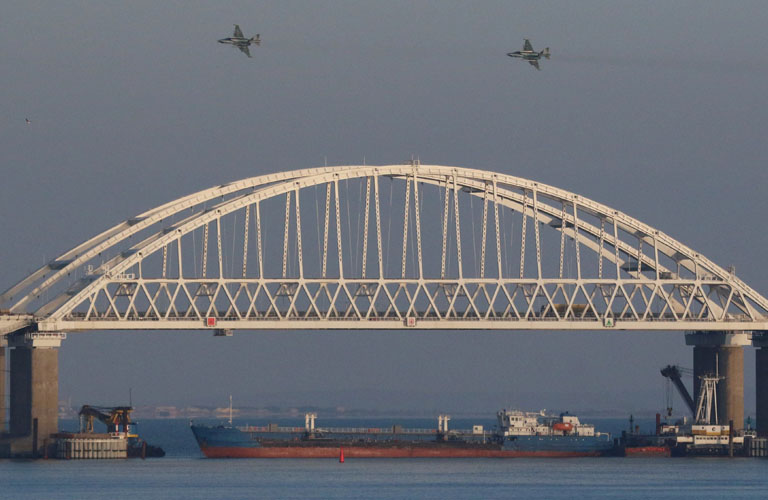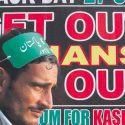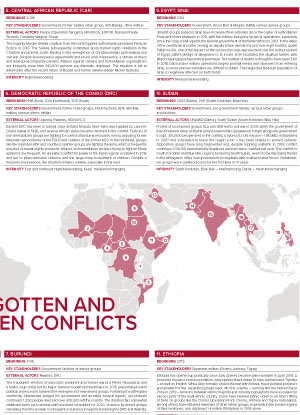Forgotten and hidden conflicts
Armed conflicts have become a constant feature of political reality in the world today: For years, the number has remained between 30 and 35 (33 at the end of 2018, according to the annual Alert! report compiled by the Autonomous University of Barcelona), with almost half of the conflicts taking place in Africa. They have been raging for years if not decades, and analysis shows that most of them have little chance of being resolved any time soon.
The causes of the conflicts vary, but can be broadly sorted into four categories: opposition to domestic or international policies of respective governments; opposition to the political, economic, social or ideological system of a state; disputes over identity-related demands and self-government; and struggles over the control of resources and territory. In most cases, government forces face non-state actors, with a variety of external parties involved either directly or indirectly through proxy forces. We feature here 19 of the conflicts that are rarely reported, hidden from view and at risk of being forgotten. They nonetheless contribute to the fear, displacement, deprivation and, in many cases, deaths of millions all across the globe.
Colombia
Beginning 1964
KEY STAKEHOLDERS Government, ELN, FARC dissidents, EPL, paramilitary groups
Violence between various paramilitary groups, criminal gangs and government forces continues despite a 2016 peace treaty with the main guerilla group FARC. The conflict dates back to 1964 when left-wing rebel groups tried to seize power and were repelled by government forces. By the 1980s, right-wing paramilitary groups, drug lords and organized crime were colluding to defend the status quo through a campaign of terror. While FARC and its allies declare they are fighting for the rights of Colombia’s poor, and the government claims to be for order and stability, all sides have been accused of human rights violations and are involved in drug-trafficking and terrorism. The situation is deteriorating, with more than 100 human rights activists killed in 2019, mainly in former FARC strongholds. More than 260,000 have died overall while more than 7 million have been displaced.
INTENSITY Low/deteriorating
West Sahel (Burkina Faso, Mali, Niger)
BEGINNING 2018
KEY STAKEHOLDERS Burkina Faso, Mali, Niger, Islamic State in the Greater Sahara (ISGS), Group to Support Islam and Muslims (GSIM/Al-Qaeda) and other Islamist groups
EXTERNAL ACTORS G5 Sahel Forces (including Mauritania, Chad), MINUSMA, France (Operation Barkhane)
In January 2020, the UN called terrorist violence in the West Sahel region unprecedented, with the number of casualties in Burkina Faso, Mali and Niger having risen to more than 4,000 in 2019. Islamist groups taking over the north of Mali in early 2012 have reorganized, built alliances and spread further south. Attacks on military camps like Inatès and Chinagodrar, which saw hundreds of Islamist militants fighting as a coordinated force, killed dozens of soldiers while showcasing their new military capabilities. Attacks on civilian targets including churches and mosques, are a near-daily occurence. Protest against the French army – despite its assistance in the states’ fight against Islamists – is rising.
INTENSITY High/deteriorating
Chad Basin (parts of Cameroon, Niger and Nigeria)
BEGINNING 2011
KEY STAKEHOLDERS Nigeria, Niger, Cameroon, Chad, Islamic State West Africa Province (ISWAP), Boko Haram (Shekau faction)
EXTERNAL ACTORS MNJTF regional forces (including Benin), US
In 2016, the Islamic sect Boko Haram, nurtured by politicians in the first decade of this century and occupying large swaths of northern Nigeria over the last 10 years, split into two major factions allying with the Islamic State and Al Qaeda respectively. Raids, kidnappings and suicide attacks in the north of Nigeria have continued since, with more than 1,600 victims in 2018 alone. Boko Haram fighters are also terrorizing southern Niger, northern Cameroon and parts of Chad. At the end of 2019, the Islamic State faction of the former Boko Haram killed some 50 members of island communities on Lake Chad where a caliphate has been established.
INTENSITY High/deteriorating
Cameroon (Anglophone/Francophone Region)
BEGINNING 2018
KEY STAKEHOLDERS Government, self-proclaimed Government of Ambazonia, armed groups and militias
What started as protests among minority English-speaking Cameroonians against marginalization by the Francophone government in 2016 escalated when security forces attacked demonstrators and arrested a main opposition figure. This led to rising support for a secessionist movement seeking independence for Ambazonia and then a full-fledged civil war that claimed an estimated 1,500 lives. The situation has calmed recently but tensions remain. The Major National Dialogue that was carried out from Sept. 30 to Oct. 4, 2019, produced a number of resolutions yet excluded the opposition.
INTENSITY Medium/unchanging
Central African Republic (CAR)
BEGINNING 2006
KEY STAKEHOLDERS Government, former Séléka rebel group, Anti-Balaka, other militias
EXTERNAL ACTORS France (Operation Sangaris), MINUSCA, EUFOR, Russian Private
Security Company Wagner Group
The majority-Muslim Séléka coalition from the north toppled authoritarian president François Bozizé in 2013. The Séléka subsequently committed gross human rights violations in the Christian and animist south, leading to the emergence of Christian militias (Anti-balaka) and civil war. Despite several peace agreements and an AU and UN presence, a climate of chaos and widespread impunity prevails. Attacks against civilians and humanitarian organizations are frequent; more than 640,000 persons are internally displaced. The situation is set to deteriorate after the recent return of Bozizé and former Séléka-leader Michel Djotodia.
INTENSITY High/deteriorating
Democratic Republic of the Congo (DRC)
BEGINNING 1998 (East), 2014 (Northeast), 2017 (Kasaï)
KEY STAKEHOLDERS Government, former rebel groups, FDLR factions, ADF, Mai-Mai militias, various ethnic militias
EXTERNAL ACTORS Uganda, Rwanda, MONUSCO
Eastern DRC has been in turmoil since dictator Mobutu Sese Seko was toppled by Laurent-Désiré Kabila in 1996, and several African states became involved in the conflict. Factions of non-demobilized groups are fighting for control of land and resources in Kivu, including former Rwandan génocidaires of the FDLR and soldiers of the former M23. In the northeast, groups like the Ugandan ADF and countless splinter groups are fighting the army, which is frequently accused of human rights violations. Attacks on humanitarian workers trying to fight an Ebola epidemic are frequent. An unrelated conflict for power in the Kasaï regions escalated in 2016 and led to intercommunal violence and the large-scale recruitment of children. Despite a massive UN presence, the situation remains volatile, especially in the east.
INTENSITY East and northeast high/deteriorating; Kasaï: medium/unchanging
Burundi
BEGINNING 2015
KEY STAKEHOLDERS Government, factions of armed groups
EXTERNAL ACTORS Rwanda, DRC
The fraudulent election of autocratic president and former warlord Pierre Nkurunziza and a failed coup d’état led by Major General Godefroid Niyombare in 2015 exacerbated latent political violence and fostered the emergence of new armed groups. Following the attempted overthrow, Nkurunziza purged his government and arrested several figures, yet protests continued. 1,200 people died and over 430,000 left the country. The situation has somewhat stabilized but is set to worsen with elections scheduled for 2020. Violence by armed groups remaining from the civil war is a frequent occurrence in regions bordering the DRC and Rwanda.
INTENSITY Low/unchanging
Mozambique
BEGINNING 2017
KEY STAKEHOLDERS Government, Ansar Al-Sunna, Islamic State (IS)
EXTERNAL ACTORS Russian Private Security Company Wagner Group
Islamist groups are fighting for control and the establishment of a caliphate in Cabo Delgado Province in the north of Mozambique. Natural gas discoveries off the coast have contributed to the recent escalation. The traditionally neglected region has been hard hit by cyclones such as Kenneth in early 2019, which further worsened living conditions for the population. Fatalities since fighting began in 2017 are estimated to be in the hundreds.
INTENSITY High/deteriorating
Egypt: Sinai
BEGINNING 2014
KEY STAKEHOLDERS Government, Ansar Beit al-Maqdis (ABM), various armed groups
Jihadist groups based in Sinai have increased their activities since the ouster of authoritarian President Hosni Mubarak in 2011, with the military being the target of operations, especially since the coup d’état against the Islamist government of Mohamed Morsi in 2013. In the wake of the overthrow and after serving as deputy prime minister for just over eight months, Abdel Fattah el-Sisi, one of the leaders of the successful coup, was elected to be the sixth president of Egypt. ABM’s pledge of allegiance to IS in late 2014 escalated the situation further, with attacks taking place beyond the peninsula. The number of deaths is thought to have been 500 in 2018, but massive military operations largely prohibit media and observers from entering Sinai, so more precise estimates are difficult to obtain. The neglected Bedouin population of Sinai is negatively affected on both fronts.
INTENSITY Medium/deteriorating
Sudan
BEGINNING 2003 (Darfur), 2011 (South Kordofan, Blue Nile)
KEY STAKEHOLDERS Government, pro-government militias, various rebel groups and factions
EXTERNAL ACTORS UNAMID (Darfur), South Sudan (South Kordofan, Blue Nile)
Protest of local armed groups SLA and JEM led to civil war in 2003 when the government of then-President Omar al-Bashir armed Arab militias (Janjaweed) to fight alongside government troops. 300,000 people died in the conflict; a hybrid AU-UN mission – UNAMID, established in 2007 and scheduled to leave the region soon – has been unable to protect civilians. Opposition groups have long fragmented and, despite toppling al-Bashir in 2019, conflict continues. 100,000 new internally displaced persons were counted last year. The conflict in South Kordofan and Blue Nile, regions bordering South Sudan, seems to be improving thanks to the willingness of the new government to negotiate with southern rebel forces. Humanitarian groups were granted access for the first time in 10 years.
INTENSITY South Kordofan, Blue Nile – low/improving; Darfur – medium/unchanging
Ethiopia
BEGINNING 2019
KEY STAKEHOLDERS Separatist militias (Oromo, Amhara, Tigray)
Ethiopia has opened up politically since Abiy Ahmed became prime minister in April 2018. A promoter of peace and reconciliation, Abiy speaks fluent Afaan Oromo, Amharic and Tigrinya – as well as English. While Abiy formally ended the war with Eritrea, freed political prisoners and allowed former separatist groups back into the country – earning him the Nobel Peace Prize in 2019 – tensions between ethnic majority and minority populations have escalated in various parts of the multi-ethnic country. Some have blamed ethnic violence on Abiy’s lifting of bans on groups like the Oromo Liberation Front. Oromo, Amhara and Tigray nationalists, among others, have attacked members of other ethnic groups, especially in the border regions of their territories, and displaced 1.4 million Ethiopians in 2018 alone.
INTENSITY Medium/unchanging
Somalia
BEGINNING 2004 (following conflict since 1991)
KEY STAKEHOLDERS Government, Al-Shabaab, clan militias, various Islamist militias
EXTERNAL ACTORS AMISOM, US, Turkey, EU NAVFOR
Islamist militia Al-Shabaab, active since 2004, continues to control large parts of the country. Government forces are unable to prevent frequent bombings like the one in December 2019 that took 85 lives. Direct elections due in 2020 are again in jeopardy. Islamist terror is exacerbated by shifting alliances of warlords and clan militias that have been fighting since the toppling of Siad Barre in 1991. At least 300,000 people have since died.
INTENSITY High/deteriorating
Iraq
BEGINNING 2003
KEY STAKEHOLDERS Government, Peshmerga forces, Shia militias, Sunni militias, ISIL
EXTERNAL ACTORS Iran, Turkey, PKK, Anti-IS coalition led by the US
Iraq is still suffering from the fall-out of the 2003 invasion by the US-led international coalition, with the main factors being violence among sectarian militias and armed opposition against international forces in the country. Public protests against rising political influence by Iran in 2019 were met with brutal force by the government. The unlawful killing of Iranian General Qassim Soleimani by the US army on Iraqi soil has further escalated the situation, while the return of IS to Iraq following destabilization continues to be a concrete threat. According to UN data, IS had between 20,000 and 30,000 fighters in Syria and Iraq in 2018.
INTENSITY High/deteriorating
Pakistan
BEGINNING 2001 (Balochistan: 2005)
KEY STAKEHOLDERS Government, Taliban, various armed forces, various nationalist militias (Balochistan)
EXTERNAL ACTORS US, Iran
Taliban fleeing the US intervention in Afghanistan in 2001 eventually created the Pakistani Taliban Movement (TTP), which has been waging war against the state and civilians ever since. The TTP relies on the tribal belt – a region along the Afghan-Pakistani border – for its recruits and looks to Al Qaeda for ideological inspiration. Many militants have been killed by military operations carried out by the Pakistan Armed Forces. The insurgency is mainly located in the northeast of the country and in the so-called tribal areas that are partly beyond government control. Major anti-terror operations in recent years have seen the number of attacks falling for the first time. In Balochistan, nationalist groups on both sides of the Iran-Pakistan-border are demanding greater control of the poor province’s rich natural resources.
INTENSITY Taliban – medium/improving; Balochistan – low/unchanging
India
BEGINNING 1967
KEY STAKEHOLDERS Government, CPI-M (Naxalites)
The armed Marxist group CPI-M, called Naxalites after the town of Naxalbari, the site of a peasant revolt in 1967, has been waging a low-level insurgency since its inception that same year. The conflicts ultimately date back to the Indian government’s failure to enact the fifth and sixth schedules of the constitution of India, which had stipulated certain tribal rights for the autonomous exploitation of local natural resources. Related violence has ebbed and flowed over the 50 years of the conflict. According to the South Asian Terrorist Portal (SATP), more than 300 people were killed in 2019 in several Indian states, mostly in the east and northeast of India. Violence had been escalating after peace negotiations failed in 2004. It decreased again in 2011, but never stopped.
INTENSITY Low/unchanging
Myanmar
BEGINNING 1948
KEY STAKEHOLDERS Government, various armed groups
Since independence in 1948, dozens of armed ethnic militias have fought the government of Myanmar, demanding recognition of their ethnic and cultural rights and – some – independence. Under military dictatorship since 1962, violence escalated and the situation has improved only since 2011, when a nominally civilian government was installed and cease-fire agreements were agreed to by most groups. The Rohingya crisis of 2017 has led to another escalation. While the situation inside Myanmar is now calm after 750,000 Rohingya fled government-led pogroms to neighboring Bangladesh, a return could well lead to new fighting, including with the armed group ARSA currently based there.
INTENSITY Low/unchanging
Thailand (South)
BEGINNING 2004
KEY STAKEHOLDERS Government, armed separatist groups
The conflict in southern Thailand dates back to more than 100 years ago when the Sultanate of Pattani was divided between today’s Thailand and the colonial power of the United Kingdom, which is now Malaysia. The fight for cultural identity continued throughout the 20th century and escalated in 2004 after a brutal counterinsurgency strategy by the government. In 2005, Prime Minister Thaksin Shinawatra claimed a broad range of emergency powers to quell the violence in the south, but his controversial efforts were in vain, as the insurgency only escalated. According to Deep South Watch, more than 7,000 people have since died in southern Thailand, one of only four Muslim majority provinces in predominantly Buddhist Thailand. The violence has recently receded, but is still present, while the movement is said to demonstrate high levels of coordination throughout its attacks.
INTENSITY Low/improving
Philippines
BEGINNING 1991
KEY STAKEHOLDERS Government, Abu Sayyaf, BIFF, Islamic State of Lanao, various Islamist militias
Militias on the majority-Muslim archipelago of Mindanao have been fighting Manila for the independence of the Moro people since 1991. BIFF has been the most active group in the struggle, suffering hundreds of casualties. Abu Sayyaf, an Islamist group, has also been fighting for a caliphate and laid siege to the city of Marawi in 2017, with 1,100 dead and over 600,000 displaced. IS-affiliated militias have launched attacks as well. A counterinsurgency by the Duterte government has been criticized for its disregard of human rights.
INTENSITY Medium/deteriorating
By Marc Engelhardt




